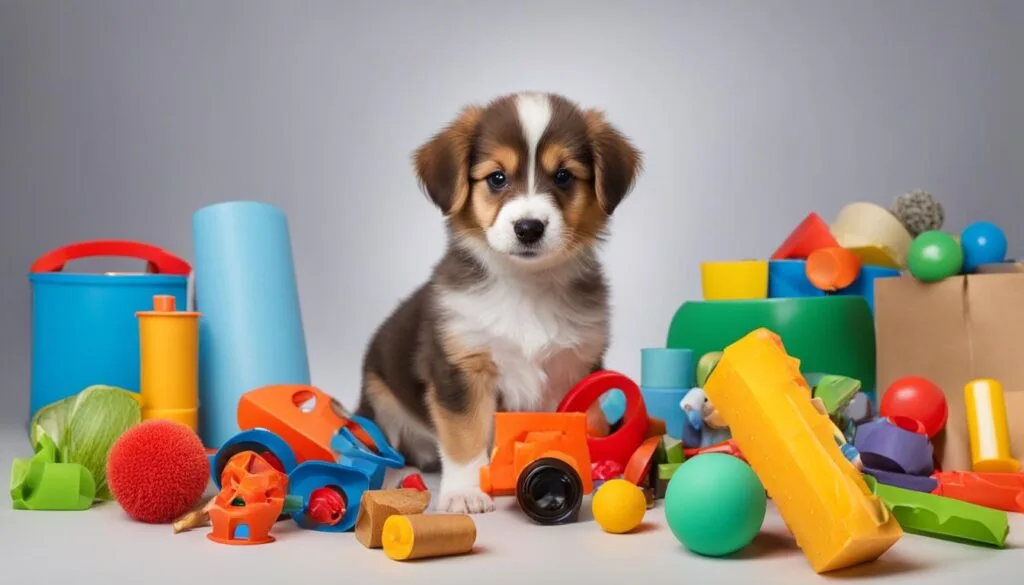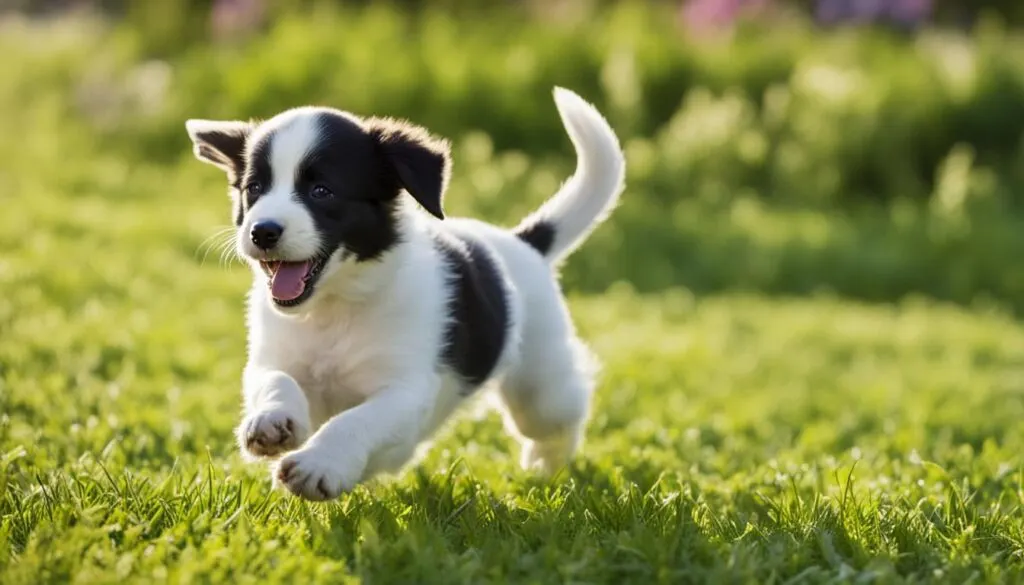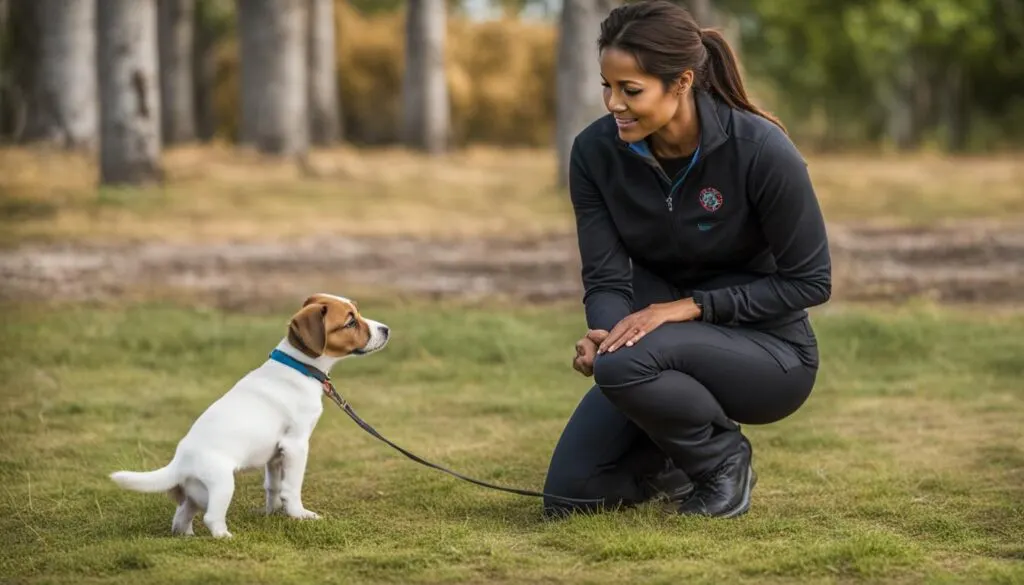Welcome to our comprehensive guide on understanding puppy behavior.
As a pet owner, it’s crucial to grasp the intricacies of your puppy’s actions to provide them with the best care possible.
In this article, we will explore various aspects of puppy behavior, including development, communication, training, socialization, and common challenges that may arise along the way.
By gaining insights into your puppy’s world, you can create a strong foundation for a happy and obedient companion.

Click Here to Jump to a Section
Key Takeaways:
- Understanding puppy behavior is essential for pet owners to provide a nurturing and supportive environment.
- Puppy behavior encompasses various aspects, including development, communication, and training.
- Puppy socialization plays a vital role in shaping their behavior and should be prioritized during their critical period.
- Canine communication signals, such as body language and vocalizations, can help owners interpret their puppies’ needs and emotions.
- Common behavior challenges in puppies, including biting, chewing, and potty training, can be addressed with proper techniques and consistency.
Canine Development: Key Milestones in a Puppy’s Life
In this section, we will explore the fascinating journey of a puppy’s development, from birth to adolescence.
Understanding the key milestones and behaviors associated with each stage is vital for pet owners seeking to provide the best care and guidance for their furry companions.
Birth to 3 Weeks: The Neonatal Stage
During this stage, puppies are entirely dependent on their mother for survival.
Their eyes and ears are closed, and they spend most of their time sleeping and nursing.
At around 2-3 weeks, their senses begin to develop, and they start to crawl and explore their surroundings.
3 to 12 Weeks: The Socialization Period
This stage is crucial for a puppy’s social development.
It is during this time that they learn to interact with their littermates, mother, and humans.
They begin to develop their senses fully and become more curious and playful.
It is also the ideal time to expose them to different environments, people, and animals to ensure proper socialization.
12 to 16 Weeks: The Fear Imprint Period
In this stage, puppies may become more cautious and susceptible to developing fear.
They may show fear of new experiences or anything unfamiliar, so it’s crucial to provide positive and controlled exposure to various stimuli to build their confidence.
4 to 6 Months: Adolescence
During this phase, puppies begin to experience hormonal changes and may exhibit behavior similar to human teenagers.
They may become more independent, test boundaries, and their energy levels may increase.
It’s important to reinforce training and continue socialization to ensure they grow into well-behaved adult dogs.
6 to 18 Months: The Juvenile Stage
This stage is characterized by rapid growth and development.
Puppies may still exhibit bursts of energy, testing limits while continuing to refine their skills and behavior.
Regular exercise, mental stimulation, and ongoing training are essential during this stage.
By understanding the various stages of puppy development, pet owners can provide the necessary care, support, and training required to help their puppies grow into well-adjusted adult dogs.
The next section will explore the importance of socialization in shaping a puppy’s behavior and development.
The Importance of Socialization for Puppies
Socialization plays a significant role in shaping a puppy’s behavior and overall development.
It is crucial for pet owners to understand the importance of exposing their puppies to different environments, people, and animals during their critical socialization period.
During the first few months of a puppy’s life, they are like sponges, absorbing everything around them.
Proper socialization allows them to learn and adapt to various stimuli, making them more confident and well-adjusted adult dogs.
Exposing puppies to different environments helps them become familiar with common sights, sounds, and smells, reducing the likelihood of fear or anxiety in new situations.
Introducing them to various people, including adults, children, and different ethnicities, helps develop their sociability and teaches them to interact with others respectfully.
Additionally, allowing puppies to interact with other vaccinated and friendly dogs is crucial for their social development.
Through positive interactions with other dogs, puppies learn important social skills such as communication, body language, and appropriate play behavior.
It is essential to expose puppies to a wide range of experiences during their formative months, including car rides, busy streets, parks, and even vet clinics.
These experiences help desensitize them to potentially stressful situations, reducing the likelihood of developing fear or aggression later in life.
Puppy socialization should be a positive and gradual process.
It is important to introduce new experiences in a controlled manner, ensuring the puppy feels safe and supported.
Gradually increasing the level of difficulty and novelty of the experiences will help puppies build confidence and resilience.
Remember, socialization is an ongoing process, and it is never too late to start.
Even if you have an older puppy or an adult dog, they can still benefit from socialization exercises and exposure to new environments.
Consult with a professional dog trainer or behaviorist for guidance on socialization techniques that are appropriate for your puppy’s age and individual needs.
Understanding Canine Communication Signals
When it comes to interacting with our furry friends, understanding their communication signals is key.
Dogs, including puppies, communicate through various forms, such as body language, vocalizations, and facial expressions.
By learning to interpret these signals, pet owners can gain valuable insights into their puppy’s thoughts, emotions, and intentions.

Body Language:
One of the primary ways dogs communicate is through their body language.
Paying attention to their posture, tail position, ear position, and facial expressions can provide important clues about how they are feeling.
For example, a relaxed wagging tail indicates happiness, while a tucked tail suggests fear or anxiety.
Furthermore, a play bow with a lowered front end and raised hind end is a common invitation to play.
Vocalizations:
Dogs use a variety of vocalizations to communicate their needs and emotions.
Barking, growling, whining, and howling are just a few examples.
Each vocalization serves a different purpose, such as warning, expressing fear or discomfort, or seeking attention.
By paying attention to the tone and intensity of your puppy’s vocalizations, you can better understand their emotional state.
Facial Expressions:
The face of a dog can convey a wealth of information.
From the position of their ears and eyes to the movements of their mouth and tongue, their facial expressions can reveal their mood and intentions.
For instance, a relaxed, open-mouthed expression indicates friendliness and relaxation, while a wrinkled forehead and narrowed eyes may signal discomfort or aggression.
By becoming familiar with these canine communication signals, pet owners can enhance their ability to understand their puppy’s behavior and respond appropriately.
This understanding promotes a stronger bond between owner and pet and helps create a safe and harmonious environment for both.
Common Puppy Behavior Challenges and Solutions
Puppies are adorable, but they can also present their owners with a variety of behavior challenges.
Understanding puppy behavior is crucial for addressing these challenges effectively and promoting their development.
In this section, we will discuss some common behavior issues that pet owners may encounter with their puppies and provide practical solutions and training tips.
Biting
Biting is a natural behavior for puppies as they explore their world and learn through their mouths.
However, it’s important to teach them appropriate bite inhibition.
When your puppy bites, firmly say “no” and redirect their attention to a chew toy or bone.
Consistently reinforcing this behavior will help them understand that biting human skin is not acceptable.
Chewing
Puppies love to chew on everything, from shoes to furniture.
To prevent destructive chewing, provide them with appropriate chew toys and bones.
Whenever you catch your puppy chewing on something they shouldn’t, calmly redirect their focus to an appropriate toy.
Consistency and positive reinforcement will help them develop good chewing habits.
Potty Training
Potty training is an essential part of raising a puppy.
Establish a routine by taking your puppy outside frequently, especially after meals or naps.
When they eliminate in the appropriate spot, praise and reward them with treats.
If accidents happen indoors, clean them up without scolding your puppy, as punishment can hinder their progress.
Remember, patience and consistency are key in potty training.
By addressing these common behavior challenges with patience, consistency, and positive reinforcement, you can help your puppy develop appropriate behavior and grow into a well-behaved adult dog.
Positive Reinforcement Training Techniques
When it comes to puppy training and shaping desired behaviors, positive reinforcement techniques have proven to be highly effective.
Unlike harsh punishment or dominance-based training methods, positive reinforcement focuses on rewarding desirable behaviors, making the learning process enjoyable for both the puppy and the owner.
Positive reinforcement training involves rewarding your puppy with treats, praise, or play whenever they perform a desired behavior.
This encourages them to repeat the behavior in the future.
By reinforcing good behavior rather than punishing bad behavior, you create a positive learning environment that fosters trust and builds a strong bond with your furry friend.
There are several key techniques that can be used in positive reinforcement training:
- Clicker Training: Clicker training is a popular positive reinforcement technique that uses a small handheld device called a clicker. The clicker is used to mark the exact moment your puppy performs the desired behavior, followed by a treat or reward. This helps create a clear and consistent association between the behavior and the reward, speeding up the learning process.
- Target Training: Target training involves teaching your puppy to touch a specific target, such as your hand or a target stick, with their nose or paw. This technique can be used to teach a variety of commands and tricks, such as sit, shake, or even agility exercises. By breaking down complex behaviors into smaller steps and rewarding each successful attempt, you can gradually shape your puppy’s behavior.
- Free-Shaping: Free-shaping is a technique that allows your puppy to offer behaviors on their own, without any prompting. By observing and rewarding behaviors that are similar to the desired behavior, you can shape and refine their actions over time. This technique encourages your puppy to think and problem-solve, promoting mental stimulation and creativity.
- Chaining: Chaining involves linking together a sequence of behaviors to create a more complex behavior. For example, teaching your puppy to sit, lie down, and roll over in succession. By rewarding each step of the chain, your puppy will learn to associate the behaviors and perform them in the desired order.
Remember, consistency and patience are key when using positive reinforcement training techniques.
Always reward your puppy immediately after they perform the desired behavior, and be sure to use high-value treats or rewards to keep them motivated.
With time, practice, and lots of positive reinforcement, your puppy will become well-trained and eager to please.
Now let’s see an image that illustrates positive reinforcement training techniques in action:

Managing Separation Anxiety in Puppies
Puppies are naturally social creatures, and being left alone can cause them to experience separation anxiety.
Understanding and addressing separation anxiety is crucial for the well-being and happiness of your furry friend.
In this section, we will explore the causes and signs of separation anxiety in puppies and provide strategies to help you alleviate their anxiety when left alone.
The Causes of Separation Anxiety
Separation anxiety can develop due to a variety of factors, such as:
- A sudden change in routine or environment
- Lack of socialization during the critical developmental period
- Previous traumatic experiences or abandonment
These factors can lead to puppies becoming overly attached to their owners and experiencing distress when separated from them.
Signs of Separation Anxiety
It’s important to recognize the signs of separation anxiety in your puppy, which may include:
- Excessive whining, barking, or howling when left alone
- Chewing on furniture or other objects
- Attempts to escape confinement (e.g., scratching at doors)
- Accidents or destructive behavior indoors
- Loss of appetite or changes in eating habits
Identifying these signs early on can help you take proactive steps to address your puppy’s anxiety.
Strategies to Alleviate Separation Anxiety
Here are some effective strategies to help manage separation anxiety in puppies:
- Gradual desensitization: Gradually expose your puppy to short periods of alone time, slowly increasing the duration over time. This helps them become more comfortable being alone.
- Provide a safe space: Create a designated area in your home where your puppy feels secure and comfortable, such as a crate or a specific room.
- Use soothing aids: Leave your puppy with comforting items, such as a favorite blanket or toy, to help them feel more at ease when you’re not around.
- Practice positive reinforcement: Reward calm behavior and independence with treats, praise, and affection. This reinforces positive associations with being alone.
- Seek professional help: If your puppy’s separation anxiety persists or worsens, consult a professional dog trainer or veterinarian who can provide specialized guidance and support.
Remember, patience and consistency are key when addressing separation anxiety in puppies.
With time and appropriate training, you can help your furry friend feel more comfortable and secure when left alone.
Addressing Fear and Aggression in Puppies
Fear and aggression are common behavioral issues that some puppies may exhibit.
Understanding the root causes behind these behaviors is crucial for pet owners to address them effectively.
By implementing proper training and socialization techniques, owners can help their puppies overcome their fears and develop healthy behavior patterns.

Identifying Fear in Puppies
Fear in puppies can manifest in various ways, such as trembling, cowering, excessive barking, or hiding.
It’s important to observe your puppy’s body language and identify the triggers that cause fear.
Common fear-inducing situations include loud noises, unfamiliar environments, or encounters with strangers or other animals.
Addressing Fear in Puppies
When addressing fear in puppies, it’s crucial to create a safe and positive environment.
Gradual exposure to fear-inducing stimuli, using desensitization techniques, can help your puppy build confidence and overcome their fears over time.
Remember to reward your puppy for calm behavior and provide plenty of praise and reassurance.
Understanding Aggression in Puppies
Aggression in puppies can stem from fear, territorial instincts, resource guarding, or lack of proper socialization.
It is important to identify the underlying cause of the aggression to address it effectively.
Pay attention to warning signs such as growling, snarling, snapping, or biting.
Addressing Aggression in Puppies
Addressing aggression in puppies requires a patient and consistent approach.
Consultation with a professional dog trainer or behaviorist may be necessary to develop a tailored training plan.
Techniques such as positive reinforcement, redirection, and teaching alternative behaviors can help manage and modify aggressive tendencies in puppies.
Remember, addressing fear and aggression in puppies requires time, patience, and consistency.
As a responsible pet owner, it’s important to seek professional guidance when necessary and provide a structured and positive environment to help your puppy develop into a well-behaved and balanced adult dog.
Final Thoughts
In conclusion, understanding puppy behavior is crucial for pet owners who want to create a nurturing and supportive environment for their furry friends.
By having a deep knowledge of their puppies’ behaviors and needs, owners can effectively meet those needs and develop a strong and positive bond with their pets.
Recognizing and responding appropriately to a puppy’s needs is essential for their healthy development.
From the various stages of puppyhood to addressing common behavior challenges, pet owners must be attentive and proactive in providing the right training, socialization, and care.
By using positive reinforcement training techniques and properly managing separation anxiety, fear, and aggression, pet owners can guide their puppies towards becoming well-behaved, happy, and confident dogs.
Building a foundation of understanding and effective communication will contribute to a harmonious relationship between owners and their beloved pets.
